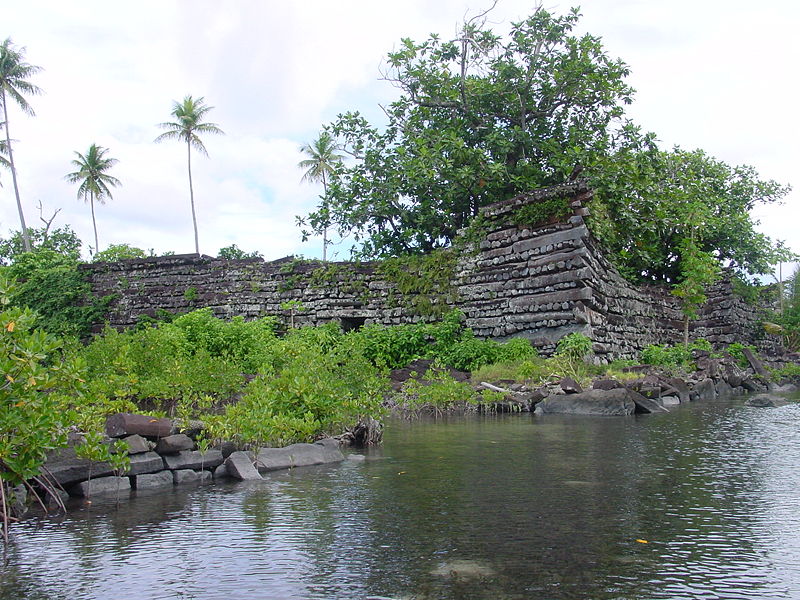Off the island of Pohnpei in Micronesia, lies the ancient city of Nan Madol, that was the capital of the Saudeleur Dynasty until about 1628. It is in the present day Madolenihmw district of Pohnpei state, in the Federated States of Micronesia in the western Pacific Ocean. The city, constructed in a lagoon, consists of a series of small artificial islands linked by a network of canals. The site core with its stone walls encloses an area approximately 1.5 km long by 0.5 km wide and it contains nearly 100 artificial islets—stone and coral fill platforms—bordered by tidal canals.
The name Nan Madol means “spaces between” and is a reference to the canals that crisscross the ruins. The original name was Soun Nan-leng (Reef of Heaven), according to Gene Ashby in his book Pohnpei, An Island Argosy. It is often called the “Venice of the Pacific”

Nan Madol was the ceremonial and political seat of the Saudeleur Dynasty, which united Pohnpei’s estimated 25,000 people until about 1628. Set apart between the main island of Pohnpei and Temwen Island, it was a scene of human activity as early as the first or second century AD. By the 8th or 9th-century islet construction had started, but the distinctive megalithic architecture was probably not begun until perhaps the 12th or early 13th century.
Pohnpeian tradition claims that the builders of the Lelu complex on Kosrae (likewise composed of huge stone buildings) migrated to Pohnpei, where they used their skills and experience to build the even more impressive Nan Madol complex. However, this is unlikely: radiocarbon dating indicates that Nan Madol predates Lelu. Like Lelu, one major purpose of constructing a separate city was to insulate the nobility from the common people.

According to Pohnpeian legend, Nan Madol was constructed by twin sorcerers Olisihpa and Olosohpa from the mythical Western Katau, or Kanamwayso. The brothers arrived in a large canoe seeking a place to build an altar so that they could worship Nahnisohn Sahpw, the god of agriculture. After several false starts, the two brothers successfully built an altar off Temwen Island, where they performed their rituals. In legend, these brothers levitated the huge stones with the aid of a flying dragon. When Olisihpa died of old age, Olosohpa became the first Saudeleur. Olosohpa married a local woman and sired twelve generations, producing sixteen other Saudeleur rulers of the Dipwilap (“Great”) clan. The founders of the dynasty ruled kindly though their successors placed ever increasing demands on their subjects. Their reign ended with the invasion by Isokelekel, who also resided at Nan Madol, though his successors abandoned the site.

The elite centre was a special place of residence for the nobility and of mortuary activities presided over by priests. Its population almost certainly did not exceed 1,000, and may have been less than half that. Although many of the residents were chiefs, the majority were commoners. Nan Madol served, in part, as a way for the ruling Saudeleur chiefs to organize and control potential rivals by requiring them to live in the city rather than in their home districts, where their activities were difficult to monitor.

Today Nan Madol forms an archaeological district covering more than 18 km² and includes the stone architecture built up on a coral reef flat along the shore of Temwen Island, several other artificial islets, and the adjacent Pohnpei main island coastline.

Carbon dating indicates that the construction of Nan Madol began around 1200 CE while excavations show that the area may have been occupied as early as 200 BCE. Some probable quarry sites around the island have been identified, but the exact origin of the stones of Nan Madol is yet undetermined.
“Nan Madol is one of the most significant sites not yet on the World Heritage List,” says Richard Engelhart, an archaeologist and former Unesco adviser for Asia and the Pacific.
In 1985, the ruins of Nan Madol were declared a National Historical Landmark. Currently, a greater effort is being made to preserve them.